Yiren Lu
S4-Driver: Scalable Self-Supervised Driving Multimodal Large Language Modelwith Spatio-Temporal Visual Representation
May 30, 2025Abstract:The latest advancements in multi-modal large language models (MLLMs) have spurred a strong renewed interest in end-to-end motion planning approaches for autonomous driving. Many end-to-end approaches rely on human annotations to learn intermediate perception and prediction tasks, while purely self-supervised approaches--which directly learn from sensor inputs to generate planning trajectories without human annotations often underperform the state of the art. We observe a key gap in the input representation space: end-to-end approaches built on MLLMs are often pretrained with reasoning tasks in 2D image space rather than the native 3D space in which autonomous vehicles plan. To this end, we propose S4-Driver, a scalable self-supervised motion planning algorithm with spatio-temporal visual representation, based on the popular PaLI multimodal large language model. S4-Driver uses a novel sparse volume strategy to seamlessly transform the strong visual representation of MLLMs from perspective view to 3D space without the need to finetune the vision encoder. This representation aggregates multi-view and multi-frame visual inputs and enables better prediction of planning trajectories in 3D space. To validate our method, we run experiments on both nuScenes and Waymo Open Motion Dataset (with in-house camera data). Results show that S4-Driver performs favorably against existing supervised multi-task approaches while requiring no human annotations. It also demonstrates great scalability when pretrained on large volumes of unannotated driving logs.
When 'YES' Meets 'BUT': Can Large Models Comprehend Contradictory Humor Through Comparative Reasoning?
Mar 29, 2025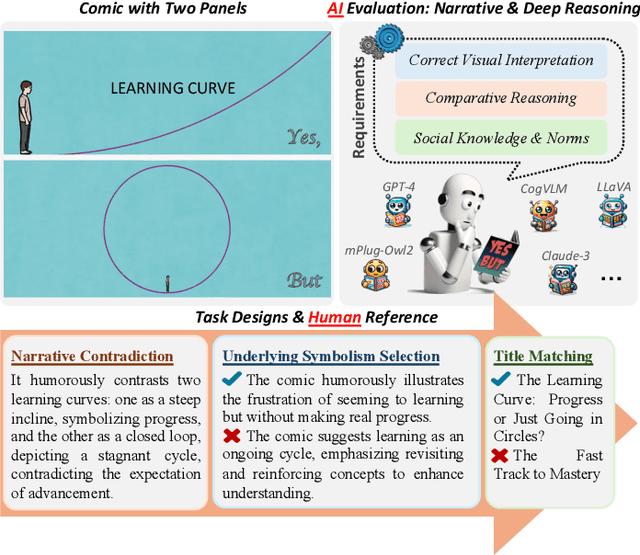



Abstract:Understanding humor-particularly when it involves complex, contradictory narratives that require comparative reasoning-remains a significant challenge for large vision-language models (VLMs). This limitation hinders AI's ability to engage in human-like reasoning and cultural expression. In this paper, we investigate this challenge through an in-depth analysis of comics that juxtapose panels to create humor through contradictions. We introduce the YesBut (V2), a novel benchmark with 1,262 comic images from diverse multilingual and multicultural contexts, featuring comprehensive annotations that capture various aspects of narrative understanding. Using this benchmark, we systematically evaluate a wide range of VLMs through four complementary tasks spanning from surface content comprehension to deep narrative reasoning, with particular emphasis on comparative reasoning between contradictory elements. Our extensive experiments reveal that even the most advanced models significantly underperform compared to humans, with common failures in visual perception, key element identification, comparative analysis and hallucinations. We further investigate text-based training strategies and social knowledge augmentation methods to enhance model performance. Our findings not only highlight critical weaknesses in VLMs' understanding of cultural and creative expressions but also provide pathways toward developing context-aware models capable of deeper narrative understanding though comparative reasoning.
Segment then Splat: A Unified Approach for 3D Open-Vocabulary Segmentation based on Gaussian Splatting
Mar 28, 2025Abstract:Open-vocabulary querying in 3D space is crucial for enabling more intelligent perception in applications such as robotics, autonomous systems, and augmented reality. However, most existing methods rely on 2D pixel-level parsing, leading to multi-view inconsistencies and poor 3D object retrieval. Moreover, they are limited to static scenes and struggle with dynamic scenes due to the complexities of motion modeling. In this paper, we propose Segment then Splat, a 3D-aware open vocabulary segmentation approach for both static and dynamic scenes based on Gaussian Splatting. Segment then Splat reverses the long established approach of "segmentation after reconstruction" by dividing Gaussians into distinct object sets before reconstruction. Once the reconstruction is complete, the scene is naturally segmented into individual objects, achieving true 3D segmentation. This approach not only eliminates Gaussian-object misalignment issues in dynamic scenes but also accelerates the optimization process, as it eliminates the need for learning a separate language field. After optimization, a CLIP embedding is assigned to each object to enable open-vocabulary querying. Extensive experiments on various datasets demonstrate the effectiveness of our proposed method in both static and dynamic scenarios.
BARD-GS: Blur-Aware Reconstruction of Dynamic Scenes via Gaussian Splatting
Mar 20, 2025



Abstract:3D Gaussian Splatting (3DGS) has shown remarkable potential for static scene reconstruction, and recent advancements have extended its application to dynamic scenes. However, the quality of reconstructions depends heavily on high-quality input images and precise camera poses, which are not that trivial to fulfill in real-world scenarios. Capturing dynamic scenes with handheld monocular cameras, for instance, typically involves simultaneous movement of both the camera and objects within a single exposure. This combined motion frequently results in image blur that existing methods cannot adequately handle. To address these challenges, we introduce BARD-GS, a novel approach for robust dynamic scene reconstruction that effectively handles blurry inputs and imprecise camera poses. Our method comprises two main components: 1) camera motion deblurring and 2) object motion deblurring. By explicitly decomposing motion blur into camera motion blur and object motion blur and modeling them separately, we achieve significantly improved rendering results in dynamic regions. In addition, we collect a real-world motion blur dataset of dynamic scenes to evaluate our approach. Extensive experiments demonstrate that BARD-GS effectively reconstructs high-quality dynamic scenes under realistic conditions, significantly outperforming existing methods.
CAUSAL3D: A Comprehensive Benchmark for Causal Learning from Visual Data
Mar 06, 2025Abstract:True intelligence hinges on the ability to uncover and leverage hidden causal relations. Despite significant progress in AI and computer vision (CV), there remains a lack of benchmarks for assessing models' abilities to infer latent causality from complex visual data. In this paper, we introduce \textsc{\textbf{Causal3D}}, a novel and comprehensive benchmark that integrates structured data (tables) with corresponding visual representations (images) to evaluate causal reasoning. Designed within a systematic framework, Causal3D comprises 19 3D-scene datasets capturing diverse causal relations, views, and backgrounds, enabling evaluations across scenes of varying complexity. We assess multiple state-of-the-art methods, including classical causal discovery, causal representation learning, and large/vision-language models (LLMs/VLMs). Our experiments show that as causal structures grow more complex without prior knowledge, performance declines significantly, highlighting the challenges even advanced methods face in complex causal scenarios. Causal3D serves as a vital resource for advancing causal reasoning in CV and fostering trustworthy AI in critical domains.
Improving Agent Behaviors with RL Fine-tuning for Autonomous Driving
Sep 26, 2024



Abstract:A major challenge in autonomous vehicle research is modeling agent behaviors, which has critical applications including constructing realistic and reliable simulations for off-board evaluation and forecasting traffic agents motion for onboard planning. While supervised learning has shown success in modeling agents across various domains, these models can suffer from distribution shift when deployed at test-time. In this work, we improve the reliability of agent behaviors by closed-loop fine-tuning of behavior models with reinforcement learning. Our method demonstrates improved overall performance, as well as improved targeted metrics such as collision rate, on the Waymo Open Sim Agents challenge. Additionally, we present a novel policy evaluation benchmark to directly assess the ability of simulated agents to measure the quality of autonomous vehicle planners and demonstrate the effectiveness of our approach on this new benchmark.
End to End Face Reconstruction via Differentiable PnP
Sep 21, 2024Abstract:This is a challenge report of the ECCV 2022 WCPA Challenge, Face Reconstruction Track. Inside this report is a brief explanation of how we accomplish this challenge. We design a two-branch network to accomplish this task, whose roles are Face Reconstruction and Face Landmark Detection. The former outputs canonical 3D face coordinates. The latter outputs pixel coordinates, i.e. 2D mapping of 3D coordinates with head pose and perspective projection. In addition, we utilize a differentiable PnP (Perspective-n-Points) layer to finetune the outputs of the two branch. Our method achieves very competitive quantitative results on the MVP-Human dataset and wins a $3^{rd}$ prize in the challenge.
View-consistent Object Removal in Radiance Fields
Aug 04, 2024Abstract:Radiance Fields (RFs) have emerged as a crucial technology for 3D scene representation, enabling the synthesis of novel views with remarkable realism. However, as RFs become more widely used, the need for effective editing techniques that maintain coherence across different perspectives becomes evident. Current methods primarily depend on per-frame 2D image inpainting, which often fails to maintain consistency across views, thus compromising the realism of edited RF scenes. In this work, we introduce a novel RF editing pipeline that significantly enhances consistency by requiring the inpainting of only a single reference image. This image is then projected across multiple views using a depth-based approach, effectively reducing the inconsistencies observed with per-frame inpainting. However, projections typically assume photometric consistency across views, which is often impractical in real-world settings. To accommodate realistic variations in lighting and viewpoint, our pipeline adjusts the appearance of the projected views by generating multiple directional variants of the inpainted image, thereby adapting to different photometric conditions. Additionally, we present an effective and robust multi-view object segmentation approach as a valuable byproduct of our pipeline. Extensive experiments demonstrate that our method significantly surpasses existing frameworks in maintaining content consistency across views and enhancing visual quality. More results are available at https://vulab-ai.github.io/View-consistent_Object_Removal_in_Radiance_Fields.
Cracking the Code of Juxtaposition: Can AI Models Understand the Humorous Contradictions
May 29, 2024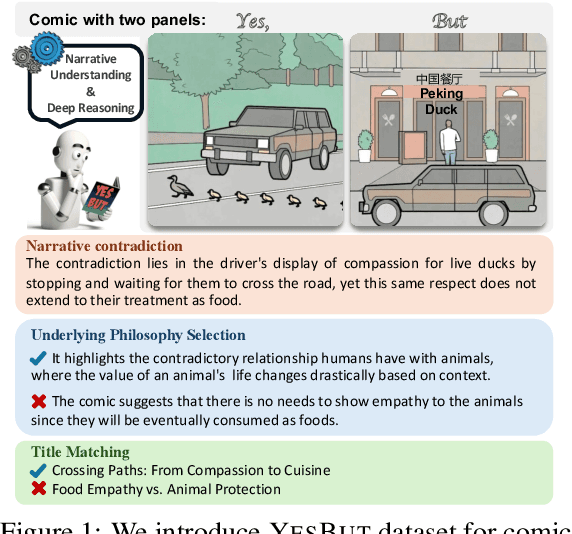
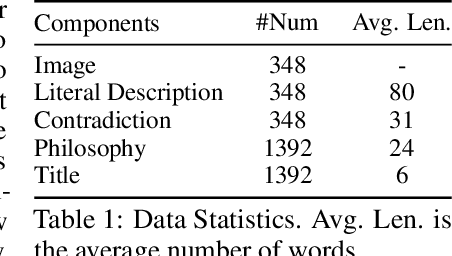
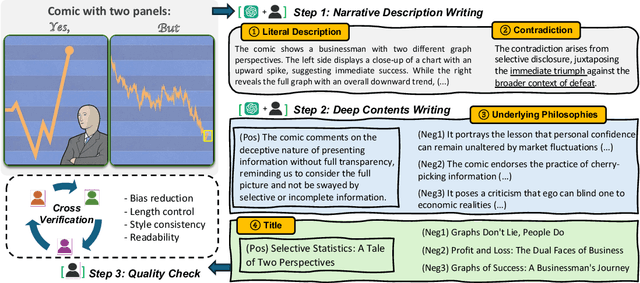
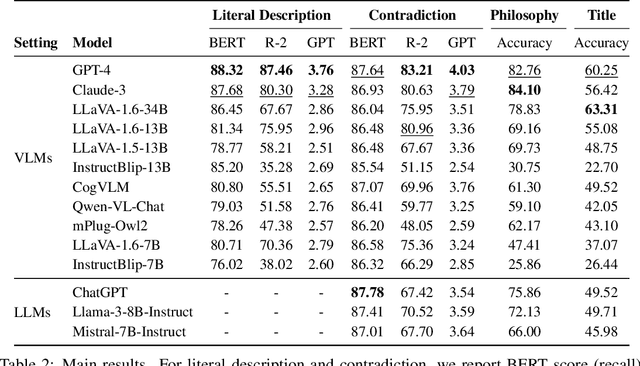
Abstract:Recent advancements in large multimodal language models have demonstrated remarkable proficiency across a wide range of tasks. Yet, these models still struggle with understanding the nuances of human humor through juxtaposition, particularly when it involves nonlinear narratives that underpin many jokes and humor cues. This paper investigates this challenge by focusing on comics with contradictory narratives, where each comic consists of two panels that create a humorous contradiction. We introduce the YesBut benchmark, which comprises tasks of varying difficulty aimed at assessing AI's capabilities in recognizing and interpreting these comics, ranging from literal content comprehension to deep narrative reasoning. Through extensive experimentation and analysis of recent commercial or open-sourced large (vision) language models, we assess their capability to comprehend the complex interplay of the narrative humor inherent in these comics. Our results show that even state-of-the-art models still lag behind human performance on this task. Our findings offer insights into the current limitations and potential improvements for AI in understanding human creative expressions.
Waymax: An Accelerated, Data-Driven Simulator for Large-Scale Autonomous Driving Research
Oct 12, 2023
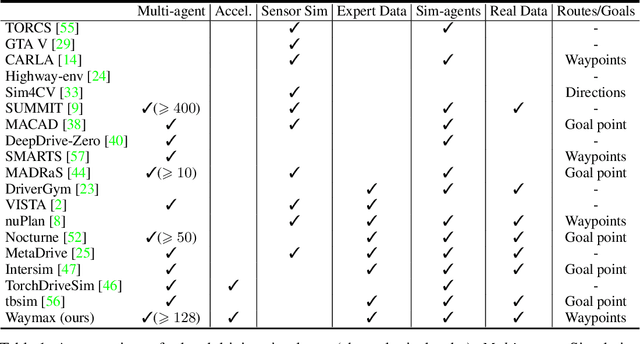


Abstract:Simulation is an essential tool to develop and benchmark autonomous vehicle planning software in a safe and cost-effective manner. However, realistic simulation requires accurate modeling of nuanced and complex multi-agent interactive behaviors. To address these challenges, we introduce Waymax, a new data-driven simulator for autonomous driving in multi-agent scenes, designed for large-scale simulation and testing. Waymax uses publicly-released, real-world driving data (e.g., the Waymo Open Motion Dataset) to initialize or play back a diverse set of multi-agent simulated scenarios. It runs entirely on hardware accelerators such as TPUs/GPUs and supports in-graph simulation for training, making it suitable for modern large-scale, distributed machine learning workflows. To support online training and evaluation, Waymax includes several learned and hard-coded behavior models that allow for realistic interaction within simulation. To supplement Waymax, we benchmark a suite of popular imitation and reinforcement learning algorithms with ablation studies on different design decisions, where we highlight the effectiveness of routes as guidance for planning agents and the ability of RL to overfit against simulated agents.
 Add to Chrome
Add to Chrome Add to Firefox
Add to Firefox Add to Edge
Add to Edge